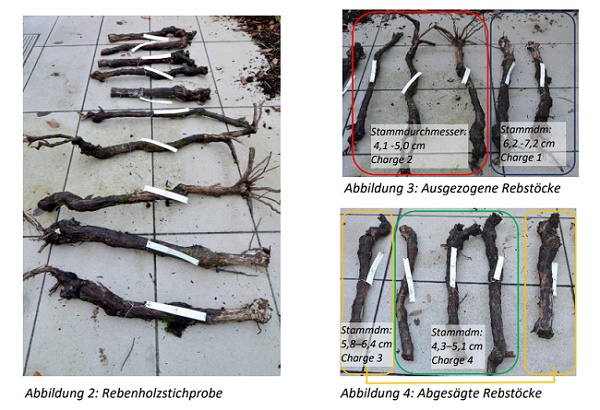
Luxembourg's Environment Administration has published a study which examined the potential of Luxembourg vinewood being used as fuel for barbecues,
What exactly is vinewood / grapevine wood?
Vinewood is understood to mean the wood of the oldest trunk and the main woody root of the vine. Vineyard prunings, which are usually one-year-old shoots, are not considered grapevine wood. Likewise, thinner root cuttings that are not completely woody are not considered as grapevine wood.
What is the quantity of vine wood produced in Luxembourg?
Wine is cultivated in Luxembourg on the western slopes of the Moselle and in some of its tributary valleys. The current area of the vineyards, mainly divided between the cantons of Remich and Grevenmacher, covers approximately 1,300 ha. The average annual area of uprooted vineyards was estimated at around 20 ha (without regrouping). The estimated annual volume of vines corresponds to a volume of between 200 and 400 tonnes.
Can vinewood be used as charcoal for the barbecue?
In neighbouring countries of Luxembourg, France, Germany and Belgium, as well as in Switzerland, there are many examples of grapevine wood being marketed as barbecue wood. The various suppliers advertise their products in particular by referring to:
• the particular "aromatic" flavour that vine wood gives to barbecue dishes,
• the embers of long-lasting vine wood,
• the "natural" appearance and symbolism of vinewood, and
• the ecological idea.
In Luxembourg, grapevine wood from abroad is available in the form of goods packed in bags in retail stores.
According to the study, vinewood from Luxembourg is also suitable as grillwood: samples of vinewood from Luxembourg show similar physical and chemical properties to natural wood. The chemical composition of untreated wood varies according to the species of tree, the natural conditions of the site, the contributions of the environment and, where appropriate, measures of fertilisation and plant protection.
To assess the suitability of vine wood from Luxembourg vineyards for use as barbecue wood, not only physical but also chemical properties must be taken into account.
The properties of the vine wood and the ash samples were determined at random (see sample image).
For the wood sample, two slices, one to two centimeters thick at the base of the stem and the head of the stem, were cut from the stems of the vines of a batch each, mixed and combined to obtain a sample. The remaining vinewood was dried in a heating compartment of a lump wood stove until it had a water content of less than 20% by weight. The wood from each batch was then burned and a sample of the ash was taken for laboratory analysis. The treatment of the wood and ash samples was carried out in the laboratory responsible for chemical analysis.
However, there is no legal requirement for the chemical composition of barbecue wood in Europe.
Ecological factors
The use of Luxembourg vinewood as barbecue wood and as an alternative to imported wood or charcoal would be an example of a regional life cycle in the direction of a circular economy.
A sustainable economy: the vine wood that accumulates comes largely from clearing that precedes the planting of new vines.
Wood Extraction: It is estimated that the energy required to harvest vines as a raw material for the production of grillwood is roughly the same as that required to harvest hardwood. In the preparation of wood, vine wood is associated with a low energy supply.
Transport: The region of origin of the barbecue wood or barbecue charcoal determines the transport effort required. The regional processing and marketing of grapevine wood results in significantly lower energy consumption and greenhouse gas emissions during transport than products from more remote areas (for example, charcoal for barbecue grills which come from Eastern Europe), which are frequently offered in the retail trade. Compared to domestic hardwood, this advantage is not applicable.
In addition, the study looked at estimating the costs and revenues that can be generated.








